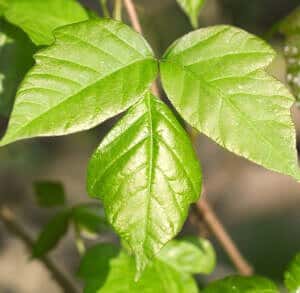
There is a hidden hazard lurking in woods, parks or even your back yard. Poison ivy, poison oak or poison sumac covers nearly the entire North American continent.
These plants make a resin called urushiol that triggers a nasty reaction in most people. The skin itches, blisters, oozes and turns red. The misery can last for days or even weeks. What’s worse, the attack can be sneaky: a person who has long assumed she doesn’t react to poison ivy can suddenly develop a sensitivity.
Watch Out for Pets:
The best way to deal with these poison plants is to avoid them. But that can be tricky. As a resin, urushiol is persistent and can linger on clothing, tools or pet fur for quite a long time. One reader reported:
“I had an eight pound Papillon that loved to sit on my left forearm with her paws in my palm. She felt quite regal. I developed a poison ivy rash right where her butt had been on my arm.”
Procedures for Prevention:
Another person described a terrible rash that occurred after she realized she had brushed up against poison ivy leaves. She took off all her clothes outside the house, then sat on the pile to pull off her boots. We can only imagine her suffering.
She’d have done better to follow this reader’s advice:
“After being outside, with any possibility of exposure to the leaves, enter the house and strip naked next to the washer. Drop the clothing into the washing machine before exposing any other part of the house to stop cross contamination.
“Hopefully a robe or towel can be kept nearby for modesty while you go immediately to the shower. Scrubbing with soap and water is critical. Use a clean towel to dry off, because the modesty towel could be contaminated. All the towels and washcloths used should be added to the wash.
“It is important to not get the urushiol resin in the house. I got it on my bed sheets once and that was the worst.”
More Protective Tips:
Prevention is paramount. Learn to recognize the leaves and avoid them. It is harder than you might think. To see pictures, visit poison-ivy.org
If you think you have come in contact with leaves but can’t immediately get into the shower, use Tecnu or Zanfel poison ivy skin cleansers as soon as you can. They are formulated to remove urushiol, so you should take a bottle with you on your hikes or camping trips.
Easing the Itch:
Once the rash appears, people have tried lots of different remedies for relieving poison ivy itching. Bad poison ivy rashes require medical attention. Corticosteroids can ease the misery, though they require a prescription and may have significant side effects.
Many readers have found other ways to calm the itch of less serious cases. One recalled:
“When we were children (over 70 years ago) we were fortunate enough to grow up in a small seaside town on the east coast of Florida. Any time anything happened to us kids–poison ivy, rashes, ant bites, bee stings–our mother would drive us over to the ocean to swim a while. That always worked.”
Another offered this:
“When I was a kid in Minnesota, mosquitoes and poison ivy were just part of summer. For any topical itch from bug or plant, I found running hot (but not burning) water on the affected area does the trick. A few minutes gives hours of relief.”
We agree that the hot water treatment is often effective for minor itches and poison ivy. Take care not to burn the skin, which could complicate recovery.

